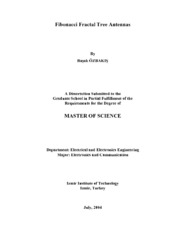Please use this identifier to cite or link to this item:
https://hdl.handle.net/11147/3348Full metadata record
| DC Field | Value | Language |
|---|---|---|
| dc.contributor.advisor | Kuştepeli, Alp | - |
| dc.contributor.author | Özbakış, Başak | - |
| dc.date.accessioned | 2014-07-22T13:51:22Z | - |
| dc.date.available | 2014-07-22T13:51:22Z | - |
| dc.date.issued | 2004 | - |
| dc.identifier.uri | http://hdl.handle.net/11147/3348 | - |
| dc.description | Thesis (Master)--Izmir Institute of Technology, Electronics and Communication Engineering, Izmir, 2004 | en_US |
| dc.description | Includes bibliographical references (leaves: 53-55) | en_US |
| dc.description | Text in English; Abstract: Turkish and English | en_US |
| dc.description | x, 55 leaves | en_US |
| dc.description.abstract | Fractal geometry is first defined by Benoit Mandelbrot. A fractal structure is generated with an iterative procedure of a simple initiator by replicating many times at different scales, positions and directions. Fractal structures generated with this method are generally self-similar and the dimensions of these structures cannot be defined with integers. Koch, Minkowski and Sierpinski structures are the most known fractal structures. These structures are commonly used as multiband and wideband antenna designs because of the self-similarity. Furthermore, their special geometry is useful to obtain small antennas which are resonant at lower frequencies. Lowering the resonant frequency has the same effect as miniaturizing the antenna at a fixed resonant frequency. Other important and interesting fractal structures used in antenna designs are the various types of the fractal trees. However, in recent studies the branch length ratios of the fractal tree antennas are taken constant. In this study fractal tree antennas with nonuniform branch length ratios are investigated. By changing the geometry and number of branches of the fractal tree structures the antenna characteristics are examined. The branch lengths and number of branches of the fractal tree antennas are determined by using the Fibonacci sequence. Leonardo Fibonacci (1170 - 1240), a famous Italian mathematician, dealt with geometry and developed a number sequence while observing the nature. Fractal tree antennas are designed with two different geometries in order to improve the resonance behavior of the antennas. The number of branches is decreased, so that less complex fractal tree antennas with the similar performance can be obtained. | en_US |
| dc.language.iso | en | en_US |
| dc.publisher | Izmir Institute of Technology | en_US |
| dc.rights | info:eu-repo/semantics/openAccess | en_US |
| dc.subject.lcc | TK7871.6 .O99 2004 | en |
| dc.subject.lcsh | Antennas (Electronics) | en |
| dc.subject.lcsh | Fractals | en |
| dc.title | Fibonacci fractal tree antennas | en_US |
| dc.type | Master Thesis | en_US |
| dc.institutionauthor | Özbakış, Başak | - |
| dc.department | Thesis (Master)--İzmir Institute of Technology, Electrical and Electronics Engineering | en_US |
| dc.relation.publicationcategory | Tez | en_US |
| dc.identifier.wosquality | N/A | - |
| dc.identifier.scopusquality | N/A | - |
| item.openairecristype | http://purl.org/coar/resource_type/c_18cf | - |
| item.languageiso639-1 | en | - |
| item.openairetype | Master Thesis | - |
| item.grantfulltext | open | - |
| item.fulltext | With Fulltext | - |
| item.cerifentitytype | Publications | - |
| Appears in Collections: | Master Degree / Yüksek Lisans Tezleri | |
Files in This Item:
| File | Description | Size | Format | |
|---|---|---|---|---|
| T000445.pdf | MasterThesis | 864.08 kB | Adobe PDF |  View/Open |
CORE Recommender
Page view(s)
298
checked on Mar 31, 2025
Download(s)
574
checked on Mar 31, 2025
Google ScholarTM
Check
Items in GCRIS Repository are protected by copyright, with all rights reserved, unless otherwise indicated.